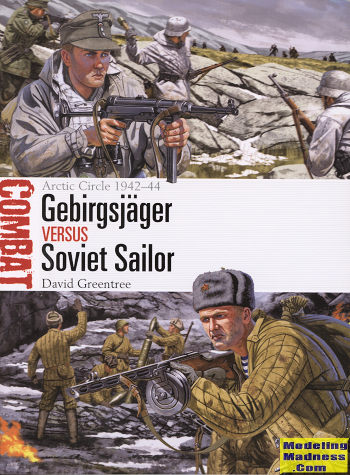Osprey's Gebirgsjäger vs Soviet Sailor
|
Author: |
David Greentree |
|
Publisher |
Osprey |
|
Price |
$19.00 MSRP |
|
Reviewer: |
Scott Van Aken
|
|
Notes: |
80 pages, 7¼ x 9¼
inches, softbound
ISBN: 978-1-4728-1979-6 |
 Next in
Osprey's Combat series is this one that takes place in the Arctic during WWII.
It was the German's goal to, if not capture Murmansk, at least cut the rail line
that led south. That would staunch the supply of materials coming into the port
from reaching industry and the Military. Operating from the Petsamo area in what
was then Northern Finland, it was a relatively short distance to Murmansk.
Next in
Osprey's Combat series is this one that takes place in the Arctic during WWII.
It was the German's goal to, if not capture Murmansk, at least cut the rail line
that led south. That would staunch the supply of materials coming into the port
from reaching industry and the Military. Operating from the Petsamo area in what
was then Northern Finland, it was a relatively short distance to Murmansk.
However, the Arctic is not a good place for warfare. In addition to the
generally horrible weather, there are few roads, which make travel difficult and
using large artillery and tanks even more of an issue. It also requires a
special type of solider to operate in these conditions.
On the German side were their mountain troops, who trained in harsh, winter
environments and were equipped to fight in this type of terrain and weather. On
the other side were the Soviet sailors, who were expected to be able to perform
amphibious assaults in order to out-flank the Germans and were also expected to
be able to defend the ports.
Well, the Germans got off to a pretty good start and made some impressive gains
through terrible conditions and the Russians were rather inept in their attempts
at not only defense but also amphibious landings. In fact, disaster would be the
operative word. However, as the war progressed, they got a lot better at things
and actually learned from their mistakes. The Germans, on the other hand, were
constantly plagued by lack of supplies and reinforcements as the far north was
not an area that really interested the OKW. Eventually the armistice between
Finland and the Soviets put an end to the struggle and allowed the very north of
Finland to be annexed by the Soviet Union.
In this book, we look at the background, training and tactics of both sides at
this time. We see the strengths and weaknesses of both sides and get a chance to
read about the progress of the fight and how the soldiers on both side fought
during the battles. It is this look into the make-up of the two armies and how
they put their training to work that really is the heart of this series. We
learn from their actions what worked well and what did not. We see what these
men went through and how the battles affected them and their comrades. The book
covers three major actions, which seems to be the standard pattern of the
series.
These are Motovskiy Bay in April/May of 1942, Liinakhamari in October of 1944,
and Nikel, also in October of 1944. I am sure that most of you, like I, have
never heard of these events and actually, that is part of what makes this such
an interesting edition. The book is further enhanced by some great period photo
and superlative art work. They provide great insight as to the difficulties of
waging war in these types of terrains and it makes for a fascinating read. This
is one of the series that I can easily recommend to you.
April 2018
Copyright ModelingMadness.com. All rights
reserved.
For more on the complete line of Osprey books,
visit www.ospreypublishing.com.
If you would like your product reviewed fairly and fairly quickly, please contact
the editor or see other details in the Note to
Contributors.
 Next in
Osprey's Combat series is this one that takes place in the Arctic during WWII.
It was the German's goal to, if not capture Murmansk, at least cut the rail line
that led south. That would staunch the supply of materials coming into the port
from reaching industry and the Military. Operating from the Petsamo area in what
was then Northern Finland, it was a relatively short distance to Murmansk.
Next in
Osprey's Combat series is this one that takes place in the Arctic during WWII.
It was the German's goal to, if not capture Murmansk, at least cut the rail line
that led south. That would staunch the supply of materials coming into the port
from reaching industry and the Military. Operating from the Petsamo area in what
was then Northern Finland, it was a relatively short distance to Murmansk.